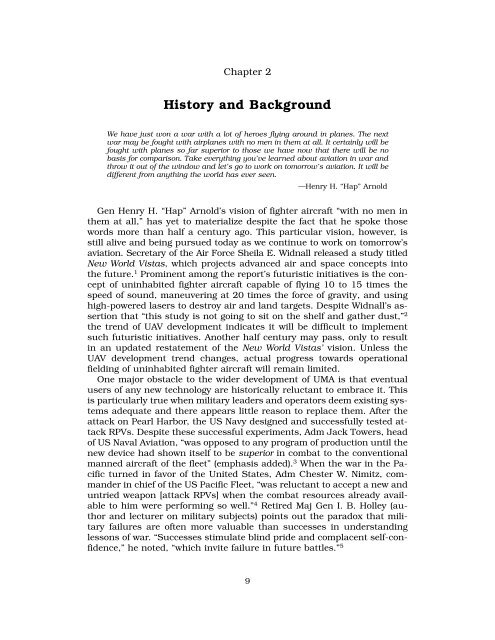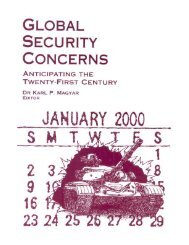Expendable Remotely Piloted Vehicles for Strategic Offensive ...
Expendable Remotely Piloted Vehicles for Strategic Offensive ...
Expendable Remotely Piloted Vehicles for Strategic Offensive ...
Create successful ePaper yourself
Turn your PDF publications into a flip-book with our unique Google optimized e-Paper software.
Chapter 2History and BackgroundWe have just won a war with a lot of heroes flying around in planes. The nextwar may be fought with airplanes with no men in them at all. It certainly will befought with planes so far superior to those we have now that there will be nobasis <strong>for</strong> comparison. Take everything you’ve learned about aviation in war andthrow it out of the window and let’s go to work on tomorrow’s aviation. It will bedifferent from anything the world has ever seen.—Henry H. “Hap” ArnoldGen Henry H. “Hap” Arnold’s vision of fighter aircraft “with no men inthem at all,” has yet to materialize despite the fact that he spoke thosewords more than half a century ago. This particular vision, however, isstill alive and being pursued today as we continue to work on tomorrow’saviation. Secretary of the Air Force Sheila E. Widnall released a study titledNew World Vistas, which projects advanced air and space concepts intothe future. 1 Prominent among the report’s futuristic initiatives is the conceptof uninhabited fighter aircraft capable of flying 10 to 15 times thespeed of sound, maneuvering at 20 times the <strong>for</strong>ce of gravity, and usinghigh-powered lasers to destroy air and land targets. Despite Widnall’s assertionthat “this study is not going to sit on the shelf and gather dust,” 2the trend of UAV development indicates it will be difficult to implementsuch futuristic initiatives. Another half century may pass, only to resultin an updated restatement of the New World Vistas’ vision. Unless theUAV development trend changes, actual progress towards operationalfielding of uninhabited fighter aircraft will remain limited.One major obstacle to the wider development of UMA is that eventualusers of any new technology are historically reluctant to embrace it. Thisis particularly true when military leaders and operators deem existing systemsadequate and there appears little reason to replace them. After theattack on Pearl Harbor, the US Navy designed and successfully tested attackRPVs. Despite these successful experiments, Adm Jack Towers, headof US Naval Aviation, “was opposed to any program of production until thenew device had shown itself to be superior in combat to the conventionalmanned aircraft of the fleet” (emphasis added). 3 When the war in the Pacificturned in favor of the United States, Adm Chester W. Nimitz, commanderin chief of the US Pacific Fleet, “was reluctant to accept a new anduntried weapon [attack RPVs] when the combat resources already availableto him were per<strong>for</strong>ming so well.” 4 Retired Maj Gen I. B. Holley (authorand lecturer on military subjects) points out the paradox that militaryfailures are often more valuable than successes in understandinglessons of war. “Successes stimulate blind pride and complacent self-confidence,”he noted, “which invite failure in future battles.” 59






